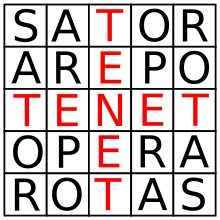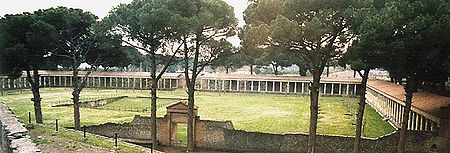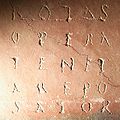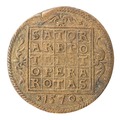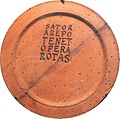Sator square
The Latin word sequence SATOR AREPO TENET OPERA ROTAS , called Sator Square , is a sentence palindrome that can be read as a magic square horizontally and vertically, forwards and backwards:
| S. | A. | T | O | R. | - "(The) Sower" |
| A. | R. | E. | P | O | - uncertain meaning |
| T | E. | N | E. | T | - "holds" (from tenere ) |
| O | P | E. | R. | A. | - "Works" (as nominative or accusative plural of opus ) or "with effort" (as ablative singular of opera ) |
| R. | O | T | A. | S. | - "Wheels" (accusative plural of rota ) |
Translation and meaning
There are several approaches to translating the word sequence. The problem is that the word AREPO, the reverse of OPERA, has no recognizable meaning. In Christian interpretations in particular, SATOR is understood as a metaphor for the Creator God.
- In one view, the text has no meaning at all. AREPO is a non-word that is only intended to complete the four lexical words squared.
- If AREPO is taken as a name, the meaning “The sower Arepo holds the wheels with difficulty” would be possible. Other interpretations suggest a word for "plow", "soil" or a connection to the verb repere , "crawl".
- Another possibility is to read the square bustrophedon (line by line alternating from left and right or column by column alternating from top and bottom) and also to double the middle line: SATOR OPERA TENET - TENET OPERA SATOR (“The sower holds the works - it keeps the works of the sower ”).
- The word AREPO, written as AREBO, appears in Swedish runes and in the Orient. Apparently this notation is easier to pronounce and makes more sense. In order to get the full quality of the square when reading backwards, the word OBERA must also be written in this way.
- Finally, an attempt is made to decipher the text by rearranging the order of the letters or with the help of numerology .
The five words form the sentence: "The sower Arepo (probably proper name) holds (tenet) the wheels (rotas) through his effort (opera)." The 25 letters of this sentence cannot be interpreted with a clear meaning what the numerous past scientific studies have shown.
Already in antiquity, the sentence opened up magical codes and prompted new interpretations and messages; it is one of the most widespread magical symbols of the West with an apotropaic function, e.g. B. against hunger, demons, evil spirits, fire, epidemics and calamity.
According to some examples known from antiquity, the sentence received a religious meaning in early Christianity. It was probably used by the first Christians as a secret identifier ( cryptogram ). The sentence is one of the oldest confessions of the Christian religion in the sense: "God sowed the world and holds the wheels of the universe in his hands." holds. A Christian reference was made both to hymns from the Gregorian repertoire ("O sator reum, reparator aevi, Christe, rex regum" and "Christe, cunctorum sator et redemptor"), as well as from the use of the Greek cross (TENET horizontal and vertical ) and the TAU cross (in the letter T between A and O).
In the 1920s, the letters of the Sator Square were also interpreted as an anagram : By rearranging 21 letters in the form of an axix around the only existing N as the center, a new symbol is created with the vertical and horizontal sequence of letters PATER NOSTER, with the remaining two being A and O (for the Christian symbols alpha and omega ) get their place in the angular fields, to be read as “Our Father, beginning and end”. There was also an attempt to rearrange the letters: ORO TE, PATER; ORO TE, PATER; SANAS and with it to form a prayer: “I pray to you, father; I pray to you, father; you heal ”.
The Sator square occurs in Coptic , Greek , Latin and German spelling.
From the 8th century onwards, the Sator Square can be found in Latin manuscripts in German monasteries, later also carved in stone or carved in wood on ecclesiastical and secular buildings. It has also been common in America since the late Middle Ages.
origin
The oldest examples found in Europe date from the first centuries AD and have been handed down as a mirror image, i. H. they begin with the word ROTAS, and not, like most squares since the 8th century, with the word SATOR.
1a) Pompeii : Rotas-Sator-Square on the stucco of the column no. LXI in the Great Palaestra , made around 55 AD and rediscovered in 1936.
1b) Pompeii : Rotas Sator Square in the house of Publius Pasquius Proculus ( Regio I, Insula VII, Domus I ), created around 55 AD and discovered in 1925 on a fragment of the black plaster.
2) Altofen ( Aquincum ) , today Budapest : Rotas-Sator-Square on a brick from the 2nd century, which comes from the palace of the Roman governor in Pannonia Inferior .
3) Conimbriga -Condeixa-a-Nova / Portugal: Brick with Quadrado Magico from the ruins of a Roman house (2nd century), today in the Museo Monográfico de Conimbriga.
4) Manchester / North East England : Rotas Sator Square on the fragment of an amphora (around 180) that was excavated in a Roman settlement; today in the Manchester Archaeological Museum.
5) Cirencester / Southern England , the Roman Corinium Dobunnorum : Rotas-Sator-Square, found on the plaster of a Roman house from the 2nd / 3rd centuries. Century, now in the Corinium Museum Cirencester.
6) Dura Europos / Syria : Outside of Europe, the sator squares from Dura Europos have gained special importance. From 1932, four finds with a Rotas-Sator square were discovered in the remains of the former temple of Azzanatheona, which date from the time between 200 and 250, when a Roman garrison was stationed in the city on the banks of the Euphrates .
Find a): Text in Latin capital letters, painted in red on a stele (approx. 23 × 21 cm), today in the Yale University Art Gallery in New Haven / Connecticut.
Finds b) and c): Incomplete text with Latin and Greek letters.
Find d): Complete Latin text written in Greek capital letters.
Overview of the most famous sator squares
The best-known examples of sator squares are listed below in chronological order, although the date of origin is partly controversial or cannot be determined:
- Pompeii, column in the great palaestra, around 55 AD
- Pompeii, fragment of plaster from the house of Publius Pasquius Proculus, around 55 AD
- Altofen ( Aquincum ), today Budapest, Roman brick, 2nd century
- Conimbriga -Condeixa-a-Nova / Portugal, Roman brick, 2nd century
- Manchester / North East England, fragment of an amphora, around 180
- Cirencester / southern England ( Corinium Dobunnorum ), wall remains, 2nd / 3rd century. Century
- Dura Europos / Syria, four finds (see above), 200 to 250
- Rome, Vatican necropolis under St. Peter's Basilica , 2nd / 3rd century Century
- Rome, Santa Maria Maggiore , piece of a tomb in the basement, 4th century
- Philadelphia ( Fayum ), papyrus sheet with coded Sator square; the text reads: sator – areto – tenet – otera – rotas. Austrian National Library Vienna, 5th century
- Capestrano / Aquila, next to the portal of San Pietro ad Oratorium, around 732
- Oppède / Vaucluse, Carré magique in a door frame, 9th century
- Pescarolo ed Uniti / Cremona, mosaic in the choir of San Giovanni Decollato, 11th century
- Aosta , S. Orso, floor mosaic with Sator inscription in S. Orso, around 1132
- Acquaviva Collecroce / Campobasso , at the old tower of S. Maria Ester, 11./12. Century
- Campotosto / Aquila, crypt of Santa Maria Apparente, 12th century?
- Sermoneta / Latium, palindrome in the shape of a circle in the Valvisciolo monastery , 12th century
- Loches / Indre et Loire, Loches Castle , Donjon , 12th century
- Jarnac-Champagne / Charente-Maritime, Castello di Jarnac, 12th century?
- Bonaguil / Département Lot-et-Garonne , graffiti in the Château de Bonaguil, 12th century?
- Arcè / Verona , palindrome above the south portal of San Michele, 12th century
- Campiglia Marittima / Livorno, under the roof of San Giovanni, 13th century
- Bozen , Maretsch Castle , by the old castle tower, 13th century
- Brusaporto / Bergamo, Castello dei Rivola, 13th century
- Siena, Cathedral of Santa Maria Assunta , on the north side, 13th century
- Paggese di Acquasanta Terme, San Lorenzo, 13th century
- Rochemaure / Ardèche, Château, on the gable of the Chapelle Saint-Laurent, 13th century?
- Magliano de 'Marsi / Aquila, palindrome on the facade of Santa Lucia, 13th century
- Aurillac / Auvergne, talisman to facilitate childbirth with the text around it: “Show this figure to a woman in childbed and she will give birth”, 13th century.
- Oberschützen / Burgenland, graffiti in the choir of St. Bartholomäus, around 1400
- Fabriano-Torrecchina / Ancona , bell of S. Maria in Plebis Flexiae, 1412
- Westerbuchberg near Traunstein, St. Peter and Paul, 15th century
- Issogne / Aosta, on the spiral staircase of Challant Castle, around 1489
- Valbonnais / Alpes-Maritimes, formerly at the courthouse, later revised, 15./18. Century
- Verona , in the entrance courtyard of Palazzo Benciolini, 16th century
- Tursac / Dordogne, Maison Forte de Reignac, 16th century
- Le Puy-en-Velay / Haute Loire, from the Saint-Michel d´Aiguilhe chapel, 16th century.
- House book with the spell “Extinguishing fire without water”, 16th century.
- Skokloster Castle near Uppsala , medal, 1570
- Stuttgart, State Museum Württemberg , medal, 16./17. Century
- Oath skull, art trade, 16./17. Century
- Lucerne , State Archives, Book from Southern Germany with Magical Recipes, 1638
- Pennsylvania , paper with talisman by Pennsylvania Germans, around 1790
- Grenoble , front door on an 18th century building
- Ascoli Satriano / Apulia, Chiesa del SS. Sacramento (13th century), replique 18th century.
- Deliceto / Foggia, Chiesa dell'Annunziata (13th century), replica 18th century.
- Tarascon / Rhône, in the west wing of Tarascon Castle, 18th century
- Bergolo / Piedmont, engraved stone, 18th century?
- Fontgillarde / Hautes-Alpes, Carré Sator for "Sebastien", 1791
- La Grave -Fréaux / Hautes-Alpes, sundial, 18th century?
- Amulet pendant, 18./19. Century
- Rennes-le-Château / Aude, menhir in which the head of King Dagobert II was carved around 700; the inscription with the Sator square on the reverse dates from 1884
- Rennes-le-Château / Aude, stone with Carré magique (today destroyed)?
- Collepardo / Frosinone, Trisulti Charterhouse , stone by the painter Filippo Balbi, 19th century
- Freistadt / Upper Austria, Mühlviertel Museum, magic spell against fire, 19th century?
- Passau , Oberhausmuseum, fire plate with magic spell, 19th century?
- Anton von Webern , memorial plaque, 1945
- Buchenbach, Our Father Chapel of the Dr. Theophil Herder-Dorneich, 1967/68
- Hallein / Salzburger Land, listed building, 1979
- Golling an der Salzach / Salzburger Land, painted house front, 20th century?
- Turin , Via Gioberti 23, painted house front, 19th century?
Use in popular culture
In his 2020 film Tenet , director Christopher Nolan takes up the motif of the Sator Square. This is the name of the main actor's antagonist, a Russian arms dealer, Andrei Sator . An art forger mentioned several times in the film goes by the name Arepo . Tenet is a code name for the protagonist's mission. The start scene takes place in an opera house ( Opera ), a key scene is a chase not only along the space, but also the time axis, with several vehicles ( Rota , d. H. Wheels).
literature
- Armin Rieble: The SATOR square , https://www.decemsys.de/sator/satorqu.htm (2001/2016).
- Gioachino Chiarini: Il Sator e il Duomo di Siena . Nuova immagine editrice, Siena 2017.
- Gerhard Rexin: Palindrome. In: Reallexikon für Antike und Christianentum , Vol. 26 (Stuttgart 2015), Sp. 785–803.
- Manfred Hühn: News about the Sator Square. In: Archive for Cultural History, 95 (2), Böhlau Verlag, Vienna and Cologne 2013, p. 437ff.
- Fabrizio Falconi: Misteri e Segreti die rione e die quartieri di Roma , Rome 2013 (without page numbers): Il quadrato magico e il palindromo nei sotterranei di Santa Maria Maggiore .
- Robert Etienne : Le “carré magique” à Conimbriga (Portugal) . In: Robert Étienne / Françoise Mayet (éd.): Itineraria hispanica, Recueil d'articles de Robert Étienne. Ausonius Éditions, Pessac 2006, pp. 45–60
- Lexicon for Theology and Church (LThK), Freiburg 2006, Volume 9, Column 83f.
- Maria Cristina Sacchi Zaffarana (ed.): SATOR AREPO. Palindrome criptografica cristiana . Tallone 2012
- Ulrich Ernst (ed.): Visual poetry - historical documentation of theoretical evidence . Volume 1: From Antiquity to the Baroque. de Gruyter, Berlin 2012, p. 4f.
- Rino Cammilleri: Il quadrato magico - Un engma che dura da duemila ani . Milan 1999
- Vittorio Messori : The Pater Noster Cryptogram of Pompeii . In: Theologisches - Katholische Monatsschrift , Volume 23, No. 4, April 1993, Column 99 ff.
- Alf Önnerfors (ed.): Ancient magic spells, Latin / German . Reclam, Ditzingen 1991,
- Heinz Hofmann : Sator square . In: Paulys Realencyclopädie der classischen Altertumswwissenschaft , Supplement 15, Stuttgart 1978, Sp. 477-565
- János Szilágyi : A brick with a magic formula from the governor's palace in Aquincum . Acta Antiqua Academiae Scientiarum Hungaricae, Vol. 2 (1954), pp. 305ff.
- Amedeo Maiuri : Sulla datazione del “quadrato magico” or criptogramma cristiano a Pompei . In: Rendiconti dell'Accademia di Archeologia, Lettere ed Arti di Napoli, XXVIII, 1953, pp. 101ff.
- Alfred Merlin in: L'Année Epigraphique (LE) 1946, p. 75
- Matthaeus della Corte: Inscriptiones Pompeianae . In: Notes degli Scavi di Antichità 1939 (NS), p. 263ff.
- Franz Dornseiff : The Rotas Opera Square . In: Journal for New Testament Science and the Customer of the Older Church , Volume 36, (1937), pp. 222-238.
Individual evidence
- ^ Ernest Bersot : Mesmer et le magnétisme animal . Librairie de L. Hachette, Paris 1853 ( PDF )
- ↑ Armin Rieble: https://www.decemsys.de/sator/satorqu.htm
- ^ Proceedings of the American Philosophical Society 115, No. 4, 1971, p. 298 ISBN 1-4223-7129-8
- ^ David Steindl-Rast : Credo . Freiburg 2nd edition 2015, p. 42
- ↑ https://www.mittelalter-lexikon.de/wiki/Magisches_Quadrat
- ↑ Robert Etienne: Le “carré magique” à Conimbriga (Portugal) . In: Robert Étienne / Françoise Mayet (éd.): Itineraria hispanica, Recueil d'articles de Robert Étienne . Ausonius Éditions, Pessac 2006, pp. 45ff.
- ↑ Amedeo Maiuri: Sulla datazione del “quadrato magico” or criptogramma cristiano a Pompei . In: Rendiconti dell'Accademia di Archeologia, Lettere ed Arti di Napoli , XXVIII, 1953, pp. 101ff.
- ↑ Matthaeus della Corte: Inscriptiones Pompeianae . In: Notes degli Scavi di Antichità 1939 (NS), p. 263ff.
- ↑ János Szilágyi: A brick with a magic formula from the palace of the governor in Aquincum . In: Acta Antiqua Academiae Scientiarum Hungaricae , Vol. 2 (1954), pp. 305ff.
- ↑ Robert Etienne: Le “carré magique” à Conimbriga (Portugal) . In: Robert Étienne / Françoise Mayet (éd.): Itineraria hispanica, Recueil d'articles de Robert Étienne . Ausonius Éditions, Pessac 2006, pp. 45ff.
- ↑ Robert Etienne: Le “carré magique” à Conimbriga (Portugal) . In: Robert Étienne / Françoise Mayet (éd.): Itineraria hispanica, Recueil d'articles de Robert Étienne . Ausonius Éditions, Pessac 2006, pp. 45ff.
- ^ Robert Étienne / Françoise Mayet (éd.): Itineraria hispanica, Recueil d'articles de Robert Étienne . Ausonius Éditions, Pessac 2006, pp. 45ff.
Web links
- https://books.openedition.org/ausonius/8207#ftn14 Robert Étienne, Le “carré magique” with images of Pompeii, Aquincum, Conimbriga and Cirencester
- https://www.archart.it/sator-arepo-tenet-opera-rotas.html Archive of archaeological images
- https://blog-d-olivier-perret.webnode.es/das-sator-rotas-quadrat-von-pompeji/ Images of Pompeii
- https://libguides.brooklyn.cuny.edu/magicancientworld/gallery_christianity Image of the Acrostic Rotas-Sator Square from Dura Europos
- http://www.enigma-sator-rotas.it/?page_id=29 Images of Pompeii, Cirencester, Manchester, Capestrano, Aosta etc.
- http://www.indaginiemisteri.it/2013/07/22/sator/ Sator squares in Europe
- http://www.angolohermes.com/simboli/sator/sator_Italia.html Sator squares in Italy
- http://www.luoghimisteriosi.it/simbolo_sator.html Sator squares in Italy
